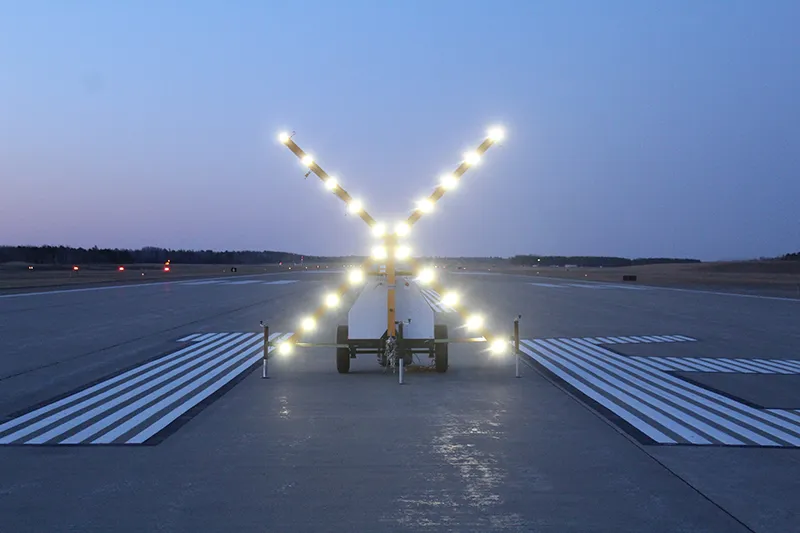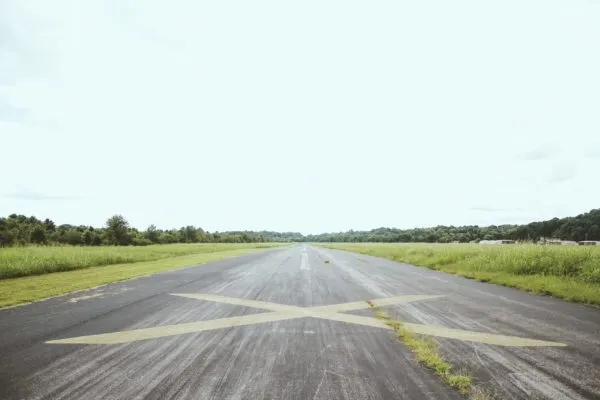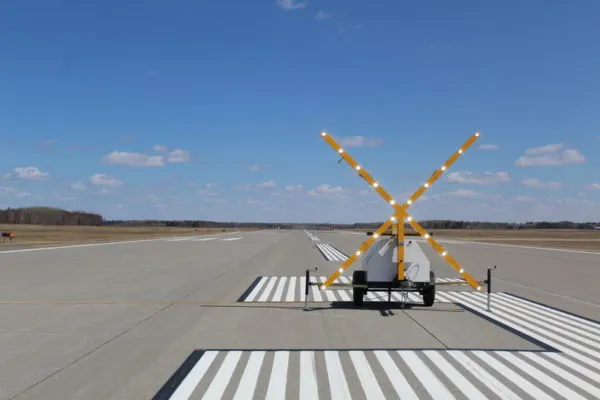Even the most perceptive frequent flyer may not understand what they’re looking at when looking out a plane window and at a bustling runway where the curious ongoings on baggage handlers and maintenance technicians take place. These flyers may witness an onslaught of bright reflective signs, rotating and flashing lights, painted numbers, and symbols. Such sights may cause alarm to the anxious traveler, but these markers are intended to have the opposite effect. The Federal Aviation Administration requires the use of certain equipment in very specific ways to keep pilots and their passengers, should they have any, safe. In the Airport Runway equipment Series, we’ll talk about the necessity of airport equipment, whether its for a large international airport, like most are used to, small grassy airfield, military airport, or even a helipad. Today’s topic is about the runway closure marker, also called a lighted X.
The Power of the Lighted X
Have you ever flown and noticed a monstrous yellow X on the runway? These crosses are painted during runway construction or when a runway has permanently closed. For temporary closures, a runway closure marker, also known as a portable lighted runway marker detail, is used. This airport marking aid is placed at the entrance of a closed taxiway and is fueled by a diesel engine. Lighted runway closures are goliaths. They consist of four arms spanning 14 feet a piece, contain a total of 20 spotlights, and are able to beam over 70,000 candelas, the unit of luminous intensity. A lighted cross’ adjustable lights can be lit during the day, or night, and are visible anywhere from 10-25 miles away. This ensure pilots can see when a runway is closed and reroute accordingly. Lighted runway closure x’s may look intimidating to those who are unsure of their intent, but they’re just like any other roadway sign, except used in the airport setting.
Portability
Since lighted closed runway markers affect airport operations, they need to be setup efficiently and in a timely manner. These lighted visual aids are foldable and attached to a small towable trailer for transport. When being moved to the runway, they’ll often be protected with a durable cover that can be fastened to the trailer with straps. Once at its position at the entrance of a runway, lighted crosses take about five minutes or so to set up, and maybe even less time for the experienced maintenance person. Setup entails separating the trailer from the vehicle towing it, using a lowering jack to achieve the proper height for the closure marker, unlatching the light assembly, unfolding and extending the pivot arms, and turning on the circuit breakers. A lighted X can operate for 140 hours until needing to be refueled.
Mobile Lighted X Necessity
Pilots may unintentionally land on improperly marked runways, especially in inclement weather like heavy snow or rainstorms. This is why it’s imperative to set up portable lighted runway closure crosses. Illuminated X’s remove ambiguity and allow pilots to see more clearly in conditions where their view is impaired. In a 2002 document, the FAA stated that “There have been an increasing number of events where aircraft have attempted to land or take off on a closed runway.” One incident even involved fatalities, so the FAA stated that runway closures need to be coordinated as early as possible. Airport personnel must work in tandem to ensure overall safety.
Compliance
The Federal Aviation Administration, FAA has set high performance standards for lighted X operation. For example, they require that closure markers “Provide fail-safe protection to ensure that the unit stays on as continuous light if the flasher unit fails.” The mobile X’s also must withstand certain wind velocities and extreme temperature conditions. They are tested and quality assured before implemented.
In conclusion, lighted visual aids to indicate temporary runway closures must be built for visibility and setup sufficiently. These signs size and attention-grabbing nature are necessary for smooth airport operations when runways are closed. So, the next time you look out the airplane window and see a runway closed x, just think of it like a stop sign: the aircraft version.



